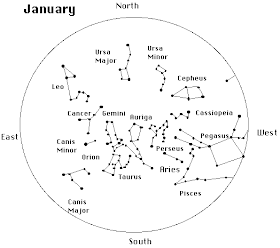 |
| Image courtesy of Kids Cosmos |
Finding constellations is actually easier than you think. The trick is to find one constellation that you know well. Almost everyone can find the Big Dipper on a clear night. This was the first constellation I learned, and I could easily find it even as a very young child. During my teenage years, I learned a second constellation, Orion, which is very easy to find because of the 3 perfectly aligned stars that make up Orion's belt. Using just these two constellations, I taught myself to find over a dozen constellations and nearly as many stars. And I'm not done yet. I decide which new constellation I want to learn and teach myself to find it without a book or any expensive star charts. Here's how:
Use the constellation that you know-- the Big Dipper as an anchor point. The first few constellations you find will be located using the Big Dipper as a reference. For example, once you can find the Big Dipper, you'll want to find the Little Dipper. To do this, I simply go to my favorite search engine, type in "Big Dipper and Little Dipper" and check the images. (By the way, you can find many stars and constellations using this technique on this site without ever using a search engine. See the links below.) You'll see the relationship between the two constellations. For this particular pair, follow the two stars on the cup of the Big Dipper out to Polaris, the handle of the Little Dipper. Practice this pair for a week. The stars will move around each other, but there relationship will not change. The next week, search for a new constellation (Cassiopeia is natural) with your anchor point. Draw your own relationship-- for Cassiopeia, I follow the place where the handle of the Big Dipper meets the cup, to the North Star (Polaris) then go in a straight line that same distance to Cassiopeia.
For any additional information, I use Wikipedia. This tells the story of the constellation and which stars can be found in it. I only note stars I've heard of-- mostly from mythology. Sometimes, you'll even find double stars or galaxies, too.
If you use this method, each time practicing the constellation for a week, you should be able to continue to add new constellations and stars, and ultimately new anchor points. This is the method I've used for all of my constellation and star entries. They are listed below.
Find Cassiopeia
Find Pleiades and Taurus
Find Cygnus and Vega
Find Pegasus
Find Draco
Find Andromeda
Find Winter Triangle
Find Regulus and Leo
Find Scorpius and Antares
Find Lyra
Find Corvus
Happy Stargazing!
No comments:
Post a Comment